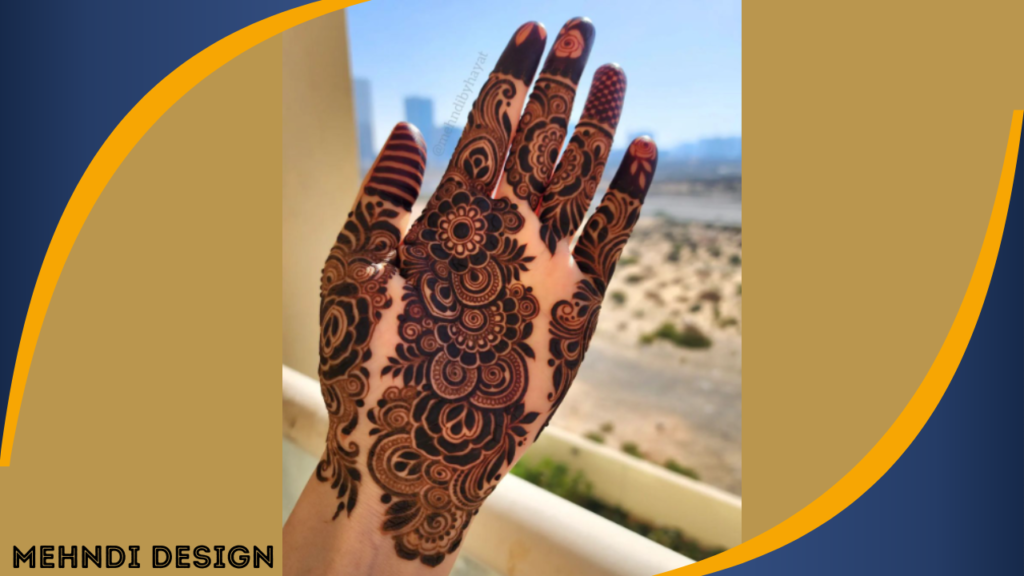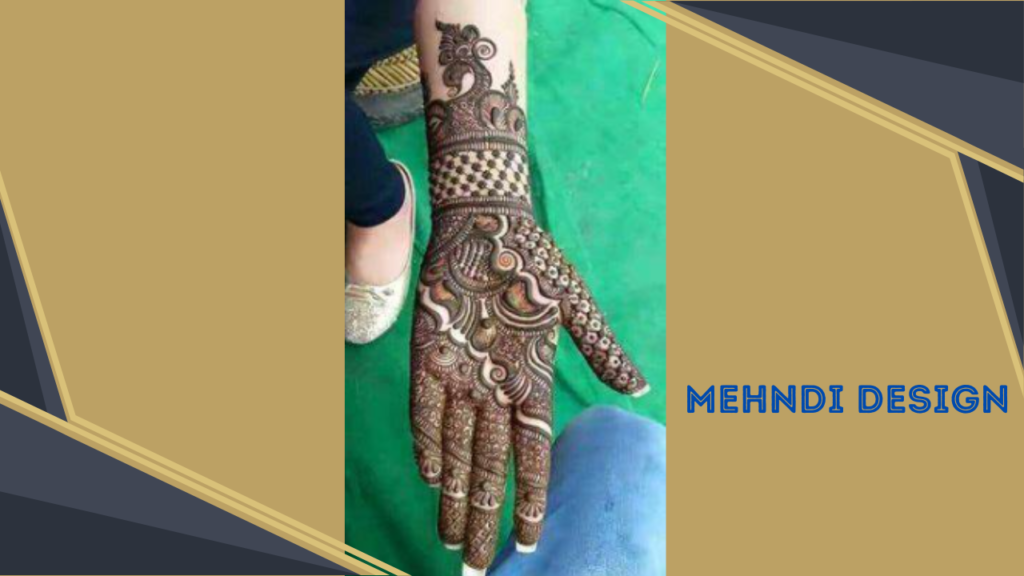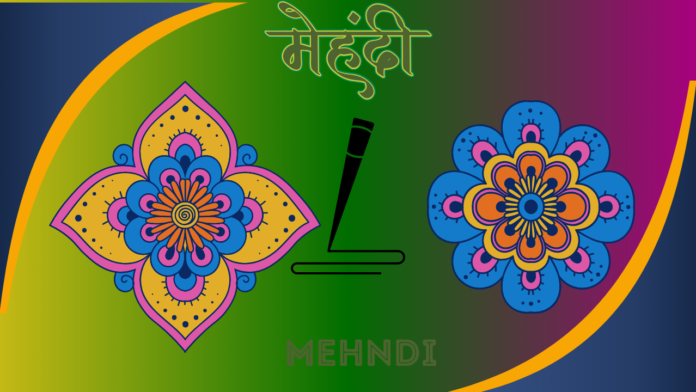what is Mehndi?
Mehndi, also known as henna, is a form of body art that involves applying a paste made from the powdered leaves of the henna plant (Lawsonia inermis) to the skin. This paste temporarily stains the skin, creating intricate and beautiful designs. Mehndi has been used for centuries in various cultures, particularly in South Asia, the Middle East, and North Africa, for ceremonial and decorative purposes. Here are some key points about mehndi:

Cultural Significance:
- Weddings: Mehndi is most commonly associated with weddings, where the bride’s hands and feet are adorned with elaborate designs. It is believed to bring good luck and is an integral part of many wedding rituals.
- Festivals: Mehndi is also applied during festivals like Eid, Diwali, Karva Chauth, and others.
- Rituals and Celebrations: It is used in various other celebrations and rites of passage, such as birthdays, pregnancies, and religious ceremonies.
Application Process:
- Preparation of Paste: The henna powder is mixed with liquids like water, lemon juice, or tea, and sometimes essential oils, to create a smooth paste.
- Application: The paste is applied to the skin using a cone or brush in intricate patterns. It is left on the skin to dry.
- Drying and Setting: As the paste dries, it forms a crust. To enhance the color, a mixture of lemon juice and sugar may be applied.
- Removal: After several hours, the dried paste is gently scraped off. The stain initially appears orange and darkens to a deep reddish-brown over the next 24-48 hours.
Types of Mehndi Designs:
- Indian: Characterized by complex patterns, including peacocks, flowers, and paisley designs, often covering large areas of the skin.
- Arabic: Features bold, less intricate patterns with floral and geometric designs, typically more spaced out.
- African: Known for its large, bold geometric shapes and tribal patterns.
- Western: Modern adaptations often include simpler, smaller designs that are more temporary and may incorporate non-traditional patterns.
Modern Usage:
- Fashion: Mehndi has found a place in contemporary fashion, with people using it for temporary tattoos and decorative body art.
- Cosmetic Industry: Some hair dyes and conditioners contain henna for its natural coloring and conditioning properties.
Mehndi continues to be a popular and cherished tradition, blending artistic expression with cultural heritage.
Easy Mehndi Design
Creating an easy mehndi design can be a fun and creative process. Here’s a simple step-by-step guide to help you create a basic mehndi design:
Materials Needed:
- Mehndi (henna) cone
- Tissue paper or a cloth for wiping any mistakes
- Lemon sugar mixture (to enhance color)
Steps to Create an Easy Mehndi Design:
- Prepare Your Hands:
- Wash your hands thoroughly to remove any oils or lotions.
- Pat them dry completely.
- Start with Simple Shapes:
- Begin with basic shapes like dots, lines, and circles. These are the building blocks of your design.
- Create a Central Motif:
- Choose a central motif for the back of your hand. It could be a flower, a mandala, or a paisley shape.
- Draw a small circle in the center and build around it with petals or curved lines.
- Extend with Vines and Leaves:
- From the central motif, extend outward with vines and leaves. These can be simple curved lines with small leaves branching off.
- Add Filler Designs:
- Fill the gaps between the main motifs with smaller designs like dots, lines, and tiny flowers.
- Use repetitive patterns to create a cohesive look.
- Design the Fingers:
- For the fingers, you can create a series of lines, dots, or small floral patterns.
- Leave some space between designs to make the patterns stand out.
- Add Borders:
- Outline your design with thin lines to give it a finished look.
- You can also add small dots along the borders for extra detail.
- Drying and Caring for the Design:
- Allow the it to dry for at least 30 minutes.
- Apply a mixture of lemon juice and sugar on the dried it to darken the stain.
- Leave the mehndi on for several hours or overnight for best results.
- Removing the Mehndi:
- Once dry, gently scrape off the mehndi paste without using water.
- Avoid washing your hands for a few hours to let the color deepen.
Example Design:
Feel free to customize the design to your liking, and practice will make your designs more intricate over time!
Are there different designs of Mehndi during festivals?
Yes, these designs are different during festivals. Every festival has its own unique style and theme, which is reflected in the mehndi designs. Here we have mentioned some popular festivals and the mehndi designs related to them:

Diwali:
- Designs: Floral patterns, paisleys, and traditional motifs. Designs are often intricate and cover the entire hand.
- Significance: Diwali ke dauran, mehndi lagana shubh mana jata hai. Log ise apni sundarta badhane aur tyohar ka maza lene ke liye lagate hain.
Eid:
Yes, these designs are different during festivals. Every festival has its own unique style and theme, which is reflected in the mehndi designs. Here we have mentioned some popular festivals and the mehndi designs related to them:
Karva Chauth:
daisigns: chomplaix daisigns with intrichatai daitailing, inchluding motifs of thai moon, bridai, and groom. significhanchai: karv chhauth par, marriaid womain apnai pati kai lambi umar ki kamn kartai huai maihndi lagati hain. yaih unkai shringar ka aik mahatvapurn ang hot hai.
Show more
258 / 5,000
Translation results
Translation result
Designs: Complex designs with intricate detailing, including motifs of the moon, bride, and groom. Significance: On Karva Chauth, married women apply mehndi while wishing for a long life of their husbands. This is an important part of their makeup.
Teej:
- Designs: Peacock designs, floral motifs, and elaborate patterns covering hands and feet.
- Significance: Teej ke dauran, suhagan auratien apni saubhagya ki kamna ke liye mehndi lagati hain. Ye tyohar shravan maas mein manaya jata hai.
Navratri:
- Designs: Simple to moderate designs with floral and geometric patterns, often less intricate compared to bridal mehndi.
- Significance: Navratri ke nau dinon ke dauran, mehndi lagana shubh mana jata hai. Yeh bhagwan Durga ki upasana aur khushi prakat karne ka ek tarika hota hai.
Raksha Bandhan:
- Designs: Simple and sweet designs, often featuring small motifs like flowers and leaves.
- Significance: Raksha Bandhan par behne apne bhaiyon ke liye mehndi lagati hain, jo unke beech ke pyar aur rishton ko aur mazboot banata hai.
Festival ke time mehndi designs alag hone ka ek karan ye bhi hai ki har festival ke saath alag-alag paramparayein aur mannatein judi hoti hain. Har design apni kahani aur mahatva batata hai, jo us festival ko aur bhi khas banata hai.
Are there different designs of Mehndi during marrige
Haan, shaadi ke mauke par mehndi designs alag aur bahut hi khas hote hain. Shaadi mehndi designs bahut hi intricate aur detailed hote hain, kyunki yeh ek bahut hi mahatvapurn rasam hai. Shaadi ke time lagayi jane wali mehndi ke kuch popular designs aur unke visheshtaon ke baare mein yeh hain:
Bridal Mehndi Designs:
- Full Hand Mehndi:
- Designs: Extremely detailed, covering the entire hand from fingers to the elbow. Common motifs include peacocks, paisleys, florals, and intricate lattice work.
- Significance: Full hand designs signify the elaborate and grand nature of the wedding. It represents the bride’s joy and excitement.
- Foot Mehndi:
- Designs: Designs for feet are equally intricate, often covering from toes to the knees. Common motifs include mandalas, paisleys, and floral patterns.
- Significance: Foot it is believed to bring good luck and prosperity to the bride.
- Arabic Bridal Mehndi:
- Designs: Characterized by bold lines and less intricate patterns, covering less area compared to traditional Indian designs. Features floral patterns, vines, and leaves.
- Significance: This style is popular for its elegance and simplicity, making it easier to apply and faster to dry.
- Rajasthani Bridal Mehndi:
- Designs: Known for its intricate and highly detailed patterns that include motifs like peacocks, royal palaces, and historical symbols.
- Significance: Rajasthani it represents the rich cultural heritage and traditions of Rajasthan.
- Moroccan Bridal Mehndi:
- Designs: Geometric shapes and lines, often creating a more modern and edgy look.
- Significance: This style is less common but chosen for its unique and contemporary appeal.
- Pakistani Bridal Mehndi:
- Designs: A blend of Indian and Arabic styles, featuring intricate patterns that cover a significant portion of the hands and feet.
- Significance: Pakistani bridal mehndi is known for its elegance and cultural richness.
- Minimalistic Bridal Mehndi:
- Designs: Simple and elegant designs with minimal coverage, focusing on key areas like the back of the hand or wrist.
- Significance: Ideal for modern brides who prefer subtlety and simplicity.
Key Motifs and Their Meanings:
- Peacock: Symbolizes beauty and grace.
- Paisley: Represents fertility and luck.
- Floral Patterns: Signify joy and happiness.
- Mandala: Represents the universe and is believed to bring positive energy.
- Bride and Groom Figures: Symbolize the union and love between the couple.
Importance of Mehndi in Weddings:
- Ritualistic Significance: it is considered auspicious and is an integral part of pre-wedding ceremonies.
- Cultural Tradition: It is a way to celebrate cultural heritage and traditions.
- Aesthetic Appeal: Enhances the beauty of the bride, making her look even more radiant on her special day.
- Symbol of Love and Bonding: Often, the groom’s name or initials are hidden in the bride’s mehndi, adding a playful element to the ceremony.
Shaadi mehndi designs na sirf sundarta ko badhate hain balki rasmon aur paramparaon ko bhi darshate hain. Yeh designs har bride ke liye unique hote hain, unki pasand aur unke rishton ka ek pratik hote hain.
FAQs About Mehndi
1. What is mehndi?
it, also known as henna, is a form of body art where a paste made from the powdered leaves of the henna plant is applied to the skin, creating intricate designs. The paste stains the skin temporarily, resulting in beautiful, decorative patterns.
2. What are the ingredients of mehndi paste?
The basic ingredients include henna powder, lemon juice or water, and sometimes essential oils like eucalyptus, tea tree, or lavender. Sugar may be added to make the paste smoother and stickier.
3. How long does mehndi last?
it stains typically last for about 1 to 2 weeks, depending on the quality of the paste, the application method, and skin type. The color gradually fades as the skin naturally exfoliates.
4. How do I make my mehndi darker?
To make it darker:
- Leave the paste on the skin for at least 6-8 hours or overnight.
- Apply a mixture of lemon juice and sugar to the dried paste.
- Keep the area warm; heat helps deepen the color.
- Avoid water for the first 24 hours after removing the paste.
5. Is mehndi safe for all skin types?
Generally, it is safe for most skin types. However, it’s important to use natural henna without chemicals or additives. Some people might be allergic to certain essential oils used in the paste. A patch test is recommended if you have sensitive skin or allergies.
6. What are the different types of mehndi designs?
There are several styles of mehndi designs:
- Indian Mehndi: Intricate and detailed with paisleys, peacocks, and floral patterns.
- Arabic Mehndi: Bold, less intricate with floral and leafy patterns.
- Moroccan Mehndi: Geometric shapes and lines.
- Pakistani Mehndi: A blend of Indian and Arabic styles with intricate patterns.
- Western Mehndi: Modern, simpler designs often used as temporary tattoos.
7. When should mehndi be applied for weddings and festivals?
For weddings, it is usually applied 2-3 days before the wedding day to allow the color to darken. For festivals, it can be applied a day or two in advance to ensure a rich color.
8. How can I care for my mehndi after application?
- Avoid washing the area for the first 24 hours.
- Apply a mixture of lemon juice and sugar to the dried mehndi to deepen the color.
- Keep the area warm and avoid activities that cause excessive sweating or friction.
9. Can mehndi be used on hair?
Yes, mehndi can be used as a natural hair dye and conditioner. It imparts a reddish-brown color and is known for its conditioning properties.
10. What is black henna, and is it safe?
Black henna contains a chemical called PPD (para-phenylenediamine) which can cause severe allergic reactions and skin burns. It is not recommended for use on the skin. Natural henna is always a safer option.
11. How do I remove mehndi stains from my skin?
it stains naturally fade with time. However, if you need to speed up the process, you can:
- Soak the area in warm, soapy water.
- Exfoliate the skin gently with a scrub.
- Apply lemon juice or a mixture of baking soda and lemon juice.
12. Why is mehndi an important part of weddings and festivals?
it holds cultural and traditional significance in many communities. It is considered auspicious and is believed to bring good luck, happiness, and prosperity. It also enhances the beauty and is a symbol of celebration and joy.



[…] Hartalika Teej 2024 is a Hindu festival celebrated primarily by women, particularly in North India. It usually occurs in the month of Bhadrapada (August-September) and is dedicated to the worship of Goddess Parvati and Lord Shiva. Women observe this festival by fasting and performing rituals for marital bliss and the well-being of their husbands. […]
[…] Hanger for Clothe and Trends: The clothes hanger is an everyday object that plays a crucial role in the maintenance and organization of garments. Despite its simplicity, its design and functionality have evolved significantly over the years. This comprehensive exploration delves into the history, design, materials, and various applications of clothes hangers, highlighting their impact on both personal and commercial clothing management. […]
[…] this step-by-step guide, we will tell you the basics of creating beautiful and simple mehndi designs. The focus will be on designs that are easy to recreate, making them suitable for every occasion. […]
LOOK